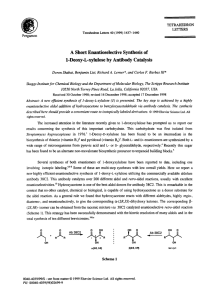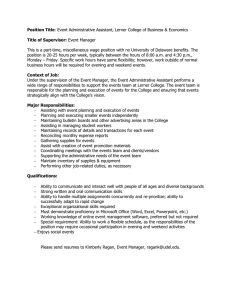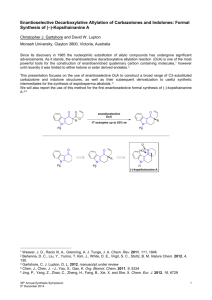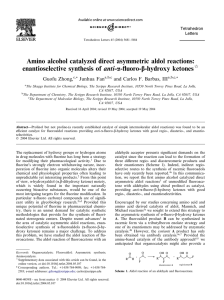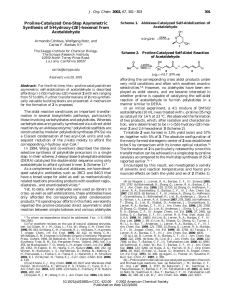Enantioselective Aldol Cyclodehydrations Catalyzed by Antibody 38C2 ORGANIC
advertisement
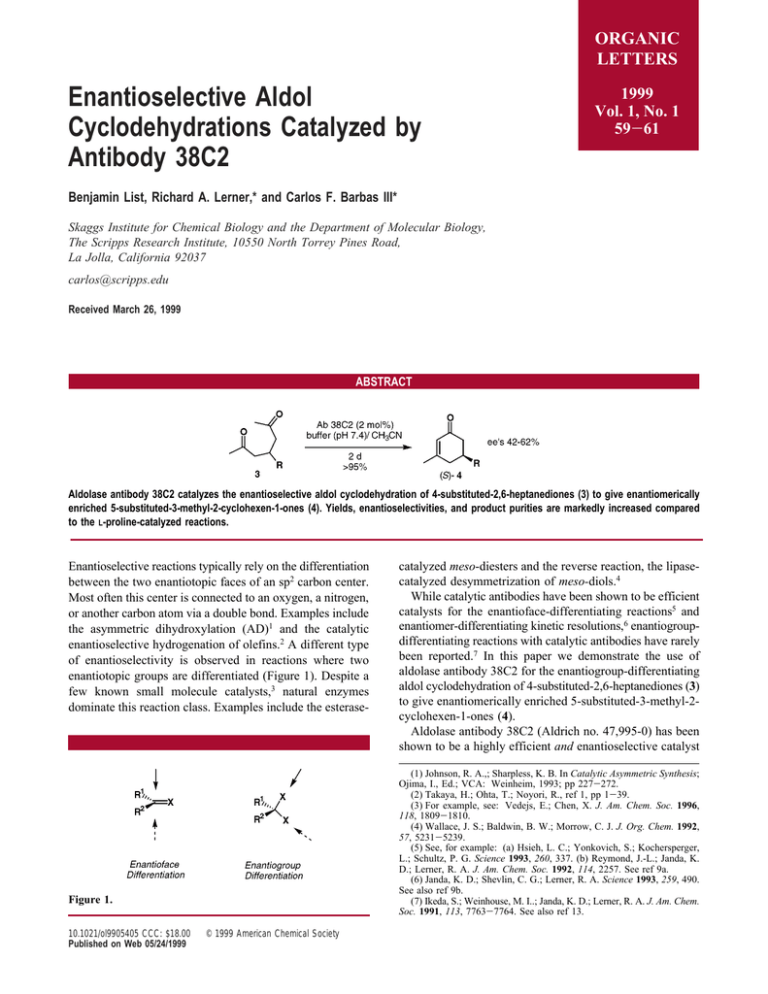
ORGANIC LETTERS Enantioselective Aldol Cyclodehydrations Catalyzed by Antibody 38C2 1999 Vol. 1, No. 1 59-61 Benjamin List, Richard A. Lerner,* and Carlos F. Barbas III* Skaggs Institute for Chemical Biology and the Department of Molecular Biology, The Scripps Research Institute, 10550 North Torrey Pines Road, La Jolla, California 92037 carlos@scripps.edu Received March 26, 1999 ABSTRACT Aldolase antibody 38C2 catalyzes the enantioselective aldol cyclodehydration of 4-substituted-2,6-heptanediones (3) to give enantiomerically enriched 5-substituted-3-methyl-2-cyclohexen-1-ones (4). Yields, enantioselectivities, and product purities are markedly increased compared to the L-proline-catalyzed reactions. Enantioselective reactions typically rely on the differentiation between the two enantiotopic faces of an sp2 carbon center. Most often this center is connected to an oxygen, a nitrogen, or another carbon atom via a double bond. Examples include the asymmetric dihydroxylation (AD)1 and the catalytic enantioselective hydrogenation of olefins.2 A different type of enantioselectivity is observed in reactions where two enantiotopic groups are differentiated (Figure 1). Despite a few known small molecule catalysts,3 natural enzymes dominate this reaction class. Examples include the esterase- (1) Johnson, R. A.,; Sharpless, K. B. In Catalytic Asymmetric Synthesis; Ojima, I., Ed.; VCA: Weinheim, 1993; pp 227-272. (2) Takaya, H.; Ohta, T.; Noyori, R., ref 1, pp 1-39. (3) For example, see: Vedejs, E.; Chen, X. J. Am. Chem. Soc. 1996, 118, 1809-1810. (4) Wallace, J. S.; Baldwin, B. W.; Morrow, C. J. J. Org. Chem. 1992, 57, 5231-5239. (5) See, for example: (a) Hsieh, L. C.; Yonkovich, S.; Kochersperger, L.; Schultz, P. G. Science 1993, 260, 337. (b) Reymond, J.-L.; Janda, K. D.; Lerner, R. A. J. Am. Chem. Soc. 1992, 114, 2257. See ref 9a. (6) Janda, K. D.; Shevlin, C. G.; Lerner, R. A. Science 1993, 259, 490. See also ref 9b. (7) Ikeda, S.; Weinhouse, M. I..; Janda, K. D.; Lerner, R. A. J. Am. Chem. Soc. 1991, 113, 7763-7764. See also ref 13. Figure 1. 10.1021/ol9905405 CCC: $18.00 Published on Web 05/24/1999 catalyzed meso-diesters and the reverse reaction, the lipasecatalyzed desymmetrization of meso-diols.4 While catalytic antibodies have been shown to be efficient catalysts for the enantioface-differentiating reactions5 and enantiomer-differentiating kinetic resolutions,6 enantiogroupdifferentiating reactions with catalytic antibodies have rarely been reported.7 In this paper we demonstrate the use of aldolase antibody 38C2 for the enantiogroup-differentiating aldol cyclodehydration of 4-substituted-2,6-heptanediones (3) to give enantiomerically enriched 5-substituted-3-methyl-2cyclohexen-1-ones (4). Aldolase antibody 38C2 (Aldrich no. 47,995-0) has been shown to be a highly efficient and enantioselective catalyst © 1999 American Chemical Society for both aldol and retro-aldol reactions with rate accelerations approaching those of natural aldolase enzymes.8 Furthermore, and in contrast to its natural counterparts, this antibody is a broad scope aldol catalyst that has been shown to work with over 200 different substrate combinations.9 We have used antibody 38C2 in the enantioselective synthesis of naturally occurring pheromone derivatives,10 deoxy-sugars,11 and in a total synthesis of epothilone A.12 Furthermore, we demonstrated its use in a preparative scale synthesis of the Wieland-Miescher ketone (2) from achiral triketone 1 (Scheme 1).13 Traditionally, this reaction is catalyzed by Scheme 1 L-proline.14 However, here the product is obtained with an ee of 71%. A related transformation that has been catalyzed by L-proline is the enantioselective cyclodehydration of 4-substituted-2,6-heptanediones (3) to the 5-substituted-3methyl-2-cyclohexen-1-ones (4) (Scheme 2).15 Stereochemi- former case (1 f 2) the enantiodifferentiation follows enamine formation, while in the latter case (3 f 4) enantiodifferentiation occurs upon enamine formation. In the L-proline-catalyzed reaction, typically low yields and enantioselectivities are observed. We found that antibody 38C2 catalyzes the cyclodehydration of 3 (R ) H) quite efficiently with kcat ) 0.082 min-1, KM ) 2 mM, and kcat/kuncat ) 1.2 × 107.9a The question was whether antibody 38C2 was capable of catalyzing this transformation with enantiogroup selectivity when provided with substrates 3 where R * H. For the synthesis of the starting 1,5-diketones 3a-c, we followed a route that has been developed by Sakurai and co-workers.16 Thus, Lewis acid mediated conjugate addition of allyltrimethylsilane to R,β-unsaturated ketones 5a-c gave olefins 6a-c.17 Wacker oxidation of δ,-unsaturated ketones 6a-c then furnished diketones 3a-c.18 Interestingly, we found that the Wacker oxidation did not require an oxygen atmosphere. Simple stirring under air furnished the products in equivalent yield.19 Racemic reference compounds 4a-c can be prepared by base treatment (KOH/MeOH) of ketones 3a-c (Scheme 3).20 Scheme 3 Scheme 2 cally, both reactions are enantiogroup-differentiating and probably occur via an enamine mechanism. However, in the (8) (a) Wagner, J.; Lerner, R. A.; Barbas, C. F., III. Science 1995, 270, 1797. (b) Barbas, C. F., III; Heine, A.; Zhong, G.; Hoffmann, T.; Gramatikova, S.; Björnestedt, R.; List, B.; Anderson, J.; Stura, E. A.; Wilson, I. A.; Lerner, R. A. Science 1997, 278, 2085-2092. (9) (a) Hoffmann, T.; Zhong, G.; List, B.; Shabat, D.; Anderson, J.; Gramatikova, S.; Lerner, R. A.; Barbas, C. F., III. J. Am. Chem. Soc. 1998, 120, 2768-2779. (b) Zhong, G.; Shabat, D.; List, B.; Anderson, J.; Sinha, S. C.; Lerner. R. A.; Barbas, C. F., III. Angew. Chem., Int. Ed. Engl. 1998, 37, 2481-2484. (c) List, B.; Barbas, C. F., III; Lerner, R. A. Proc. Natl. Acad. Sci. U.S.A. 1998, 15351-15355. (10) List, B.; Shabat, D.; Barbas, C. F., III; Lerner, R. A. Chem. Eur. J. 1998, 4, 881-885. (11) Shabat, D.; List, B.; Lerner, R. A.; Barbas, C. F., III. Tetrahedron Lett. 1999, 40, 1437-1440. (12) Sinha, S. C.; Barbas, C. F., III; Lerner, R. A. Proc. Natl. Acad. Sci. U.S.A. 1998, 14603-14608. (13) Zhong, G.; Hoffmann, T., Lerner, R. A., Danishefsky, S.; Barbas, C. F., III. J. Am. Chem. Soc. 1997, 119, 8131-8132. 60 The results of the antibody-catalyzed cyclization of diketones 3 are shown in Scheme 4. (14) (a) Eder, U.; Sauer, G.; Wiechert, R. Angew. Chem., Int. Ed. Engl. 1971, 10, 496-497. (b) Hajos, Z. G.; Parrish, D. R. J. Org. Chem. 1974, 39, 1615-1621. (15) Agami, C.; Platzer, N.; Sevestre, H. Bull. Soc. Chim. Fr. 1987, 2, 358-360. (16) Hosomi, A.; Kobayashi, H.; Sakurai, H. Tetrahedron Lett 1980, 21, 955-958. (17) Hosomi, A.; Sakurai, H. J. Am. Chem. Soc. 1977, 99, 1673-1675. The yield of olefin 6c was diminished from concurrent cyclobutane formation. A similar observation has been made by Hosomi et al. (ref 16). (18) Tsuji, J.; Shimizu, I.; Yamamoto, K. Tetrahedron Lett. 1976, 29752976. (19) Doron Shabat, The Scripps Research Institute, personal communication. Org. Lett., Vol. 1, No. 1, 1999 Scheme 4 Scheme 5 Antibody 38C2 (10 µM, 2 mol %) catalyzes the cyclodehydration of diketones 3a-c (500 µM in phosphate buffered saline (PBS), pH 7.4, 10% CH3CN) very efficiently to give the (S)-configured products 4a-c with yields generally exceeding 95%. The enantioselectivity of these reactions is moderate to good. The ee’s were determined by chiral-phase HPLC analysis.21 To determine the absolute configuration of enones 4a-c, we used the products from the L-proline-catalyzed reaction as a reference standard. This transformation is known to give the corresponding (R)-isomers (Scheme 5). All products obtained from the L-proline-catalyzed reactions had a configuration opposite that of the products produced in the antibody-catalyzed reaction as determined by chiral-phase HPLC analyses.20 Interestingly, and in contrast to these results, in the Wieland-Miescher case both L-proline and 38C2 gave the same enantiomer. In summary, aldolase antibody 38C2 has been shown to be an efficient catalyst for the enantiogroup-differentiating cyclodehydration of 4-substituted 2,6-heptanediones. The observed enantioselectivities are modest in comparison to the exceptional high ee’s that are usually obtained in aldol additions and retro-aldol reactions catalyzed by antibody 38C2.9a,b However, product yields, purities, and to some extent enantioselectivities are far better than those obtained from the corresponding L-proline-catalyzed reactions. (20) All new compounds gave satisfactory spectroscopic data (1H and NMR and HRMS). (21) 4a and 4b: Chiracell ODR, 60% H2O (0.1% TFA), 40% CH3CN, 0.6 mL/min. 4c: Chiracell ODR, 70% H2O (0.1% TFA), 30% CH3CN, 0.6 mL/min. (S)-4a 46.5 min, (R)-4a 49.0 min; (S)-4b 51.8 min, (R)-4b 50.7 min; (S)-4c 48.2 min, (R)-4c 45.0 min. 13C Org. Lett., Vol. 1, No. 1, 1999 Acknowledgment. This study was supported in part by the NIH (CA27489). B.L. thanks the Alexander von Humboldt Stiftung, Germany, for a Feodor Lynen fellowship. OL9905405 61
